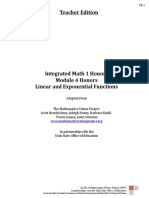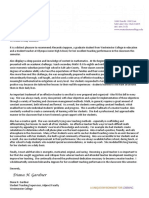Unit Theme
Unit Theme
Uploaded by
api-285095897Copyright:
Available Formats
Unit Theme
Unit Theme
Uploaded by
api-285095897Original Title
Copyright
Available Formats
Share this document
Did you find this document useful?
Is this content inappropriate?
Copyright:
Available Formats
Unit Theme
Unit Theme
Uploaded by
api-285095897Copyright:
Available Formats
Unit Theme
Enduring Understandings:
Seeing the big picture makes things clearer.
Essential Questions:
Can a visual representation help you learn?
Can looking at the whole give insight to the pieces?
Can looking at the pieces give insight to the whole?
CCSS:
F.IF.4: For a function that models a relationship between two quantities, interpret key features
of graphs and tables in terms of the quantities, and sketch graphs showing key features given a
verbal description of the relationship. Key features include: intercepts, intervals where the
function is increasing, decreasing, positive, or negative and end behavior.
F.IF.5: Relate the domain of a function to its graph and, where applicable, to the quantitative
relationship it describes.
F.IF.7: Graph functions expressed symbolically and show key features of the graph, by hand in
simple cases and using technology for more complicated cases. Graph linear functions and
show intercepts.
F.LE.1: Recognize situations in which one quantity changes at a constant rate per unit interval
relative to another.
A.CED.2: Create equations in two or more variables to represent relationships between
quantities; graph equations on coordinate axes with labels and scales.
A.REI.10: Understand that the graph of an equation in two variables is the set of all its solutions
plotted in the coordinate plane, often forming a curve (which could be a line).
S.ID.7: Interpret the slope (rate of change) and the intercept (constant term) of a linear model
in the context of the data.
Time Frame:
About 8 days
Unit Concepts:
Motion
detectors
Linear/non
-linear
Continuous
/Discrete
Price for
burger
Road signs
Time,
distance,
speed
Speed
Independent/
Dependent
Rate of
change
Relations
Slope
Stairs
Graphing
Functions
Slope
Intercept
Intercepts
Keypoints
Starting
point
Domain
& Range
Equations
Positive &
Negative
Increase,
Decrease, and
Constant
Interval
notation
Point
Slope
Standard
You might also like
- A2 U3 LP Introduction To Rational FunctionsDocument17 pagesA2 U3 LP Introduction To Rational FunctionsNeil Virgel Inding0% (1)
- Plank Algebra 1 Curriculum MapDocument4 pagesPlank Algebra 1 Curriculum MapE. Ryan Plank100% (1)
- Coordinate Algebra Unit 3Document8 pagesCoordinate Algebra Unit 3crazymrstNo ratings yet
- CCSS Algebra Concept Organizer - 10!3!13Document5 pagesCCSS Algebra Concept Organizer - 10!3!13rcarteagaNo ratings yet
- Step 1: Objective Statement: Sample SLO Algebra 1Document5 pagesStep 1: Objective Statement: Sample SLO Algebra 1musicguy84No ratings yet
- Ut4 ConceptDocument1 pageUt4 Conceptapi-261139685No ratings yet
- Overarching Eus and EqsDocument16 pagesOverarching Eus and Eqsapi-267873526No ratings yet
- Growing Growing Growing Unit PlanDocument22 pagesGrowing Growing Growing Unit Planapi-250461623100% (1)
- Lesson Plan2 23Document2 pagesLesson Plan2 23api-265657141No ratings yet
- Bks MaiHL 04uu tn00 XxaannDocument26 pagesBks MaiHL 04uu tn00 XxaannSagarNo ratings yet
- Algebra 1 ScheduleDocument12 pagesAlgebra 1 ScheduledyksterkNo ratings yet
- Digital Unit Plan Template Edsc 304Document4 pagesDigital Unit Plan Template Edsc 304api-312390227No ratings yet
- HIDOE Algebra I Course OutlineDocument20 pagesHIDOE Algebra I Course OutlineMichael PearsonNo ratings yet
- Polynomial Functions Unit PlanDocument10 pagesPolynomial Functions Unit Planapi-255851513No ratings yet
- A1u2 Student Friendly Standards 2Document2 pagesA1u2 Student Friendly Standards 2api-297405956No ratings yet
- Hs TM FuncDocument17 pagesHs TM Funcapi-302575416No ratings yet
- HSAlgebrallCurriculum2022 1Document55 pagesHSAlgebrallCurriculum2022 1GopinathNo ratings yet
- Midrange PlanDocument9 pagesMidrange Planapi-663575973No ratings yet
- Algebra II Unit 1 PlanningDocument7 pagesAlgebra II Unit 1 PlanningAdam LadjNo ratings yet
- Algebra I Pacing Guides 2015-2016 1Document9 pagesAlgebra I Pacing Guides 2015-2016 1api-252392763No ratings yet
- Las - Q2 - English 7 Week 7Document11 pagesLas - Q2 - English 7 Week 7NIMFA PALMERANo ratings yet
- Shelton 5e-Lesson-PlanDocument10 pagesShelton 5e-Lesson-Planapi-595118822No ratings yet
- Kirk Handout5Document14 pagesKirk Handout5Zamanoden D. UndaNo ratings yet
- Quadratic Functions Unit PlanDocument10 pagesQuadratic Functions Unit Planapi-255851513No ratings yet
- Research Process On StabilityDocument33 pagesResearch Process On StabilityRamkumarNo ratings yet
- EN200 Naval Engineering Chapter 1 PDFDocument33 pagesEN200 Naval Engineering Chapter 1 PDFanusha_wiproNo ratings yet
- DVT - Unit 2 NotesDocument31 pagesDVT - Unit 2 NotesYashwanthNo ratings yet
- Algebra 1-2 Curriculum Map All UnitsDocument31 pagesAlgebra 1-2 Curriculum Map All Unitsapi-281539956No ratings yet
- Course Objectives 1 Engineering FundamentalsDocument33 pagesCourse Objectives 1 Engineering FundamentalsbapineeduNo ratings yet
- Bks MaaHL 07uu tn00 XxaannDocument43 pagesBks MaaHL 07uu tn00 XxaannReyansh ParmarNo ratings yet
- Schaffert Unit Plan Linear EquationsDocument7 pagesSchaffert Unit Plan Linear Equationsapi-284366080No ratings yet
- Snyder - Edi 431 Unit Plan Portfolio Version 2Document73 pagesSnyder - Edi 431 Unit Plan Portfolio Version 2api-248778922No ratings yet
- Intro To FunctionsDocument2 pagesIntro To FunctionsnooluoitNo ratings yet
- Overland TrailDocument8 pagesOverland Trailapi-245623862No ratings yet
- Develop Stage 1 of Your Unit Plan Using The Template Below:: Grade 9: Exponents and Exponential FunctionsDocument3 pagesDevelop Stage 1 of Your Unit Plan Using The Template Below:: Grade 9: Exponents and Exponential FunctionsStarr LevyNo ratings yet
- For Mam Fe Q2 052 DLP Relations and Functions Graph of A FunctionDocument3 pagesFor Mam Fe Q2 052 DLP Relations and Functions Graph of A FunctionLeonafe PabloNo ratings yet
- ISM ProjectDocument11 pagesISM ProjectJatin SinghNo ratings yet
- Brittany - Math UnitDocument23 pagesBrittany - Math Unitapi-512405061No ratings yet
- Alg 2 CompleteDocument211 pagesAlg 2 CompleteAnik MondalNo ratings yet
- Chap 06Document23 pagesChap 06anayaNo ratings yet
- Dependent & Independent VariablesDocument32 pagesDependent & Independent VariablesChrist OcampoNo ratings yet
- 337 Final ProjectDocument10 pages337 Final Projectapi-209574864No ratings yet
- Gen. Math FunctionsDocument39 pagesGen. Math FunctionsSynergyNo ratings yet
- Math 10C RF 1, 2, 8: Relations and Functions Notes and Class ExamplesDocument11 pagesMath 10C RF 1, 2, 8: Relations and Functions Notes and Class ExamplesMuhammad TahirNo ratings yet
- Linear Functions Unit Lesson Plan PreviewDocument1 pageLinear Functions Unit Lesson Plan Previewapi-270341664No ratings yet
- 2 BPT Template 6200Document2 pages2 BPT Template 6200api-288318661No ratings yet
- Performance Task 2Document3 pagesPerformance Task 2api-535003994No ratings yet
- CHSD230 Math 1 Honors Module 4H TEDocument110 pagesCHSD230 Math 1 Honors Module 4H TEAngela LynnNo ratings yet
- Chapter 6 Unit PlanDocument13 pagesChapter 6 Unit Planapi-282333715No ratings yet
- A Visual Inspection of The Real Roots of A Polynomial FunctionDocument10 pagesA Visual Inspection of The Real Roots of A Polynomial FunctionxcrunitccNo ratings yet
- Avl-Las Q4Document12 pagesAvl-Las Q4Metmet Abrea PahitNo ratings yet
- Functions Lesson Plans EdtpaDocument7 pagesFunctions Lesson Plans Edtpaapi-272608829No ratings yet
- Advanced Algebra Trig Pacing Guide: Big Ideas Enduring Understandings Essential QuestionsDocument11 pagesAdvanced Algebra Trig Pacing Guide: Big Ideas Enduring Understandings Essential Questionsapi-305244588No ratings yet
- Gallichio Teaching Students With A Lesson PlanDocument10 pagesGallichio Teaching Students With A Lesson Planapi-663575973No ratings yet
- Programming Distributed Computing Systems: A Foundational ApproachFrom EverandProgramming Distributed Computing Systems: A Foundational ApproachNo ratings yet
- Digital SAT Math Prep For Dummies, 3rd Edition: Book + 4 Practice Tests Online, Updated for the NEW Digital FormatFrom EverandDigital SAT Math Prep For Dummies, 3rd Edition: Book + 4 Practice Tests Online, Updated for the NEW Digital FormatNo ratings yet
- Letter of Recommendation Diana GardnerDocument1 pageLetter of Recommendation Diana Gardnerapi-285095897No ratings yet
- Final EvalDocument7 pagesFinal Evalapi-285095897No ratings yet
- Daily Lesson Plan Defining TermsDocument1 pageDaily Lesson Plan Defining Termsapi-285095897No ratings yet
- Defining TermsDocument19 pagesDefining Termsapi-285095897No ratings yet
- Cell Phone ProjectDocument5 pagesCell Phone Projectapi-285095897No ratings yet
- 6 Daily Lesson Plan BungeeDocument3 pages6 Daily Lesson Plan Bungeeapi-285095897No ratings yet
- Cia IDocument12 pagesCia Iapi-285095897No ratings yet
- Interest SurveyDocument1 pageInterest Surveyapi-285095897No ratings yet
- WH 5Document2 pagesWH 5api-285095897No ratings yet
- Final Exam 2: Alex Jeppson April 27, 2014Document2 pagesFinal Exam 2: Alex Jeppson April 27, 2014api-285095897No ratings yet
- Shortessay 4Document6 pagesShortessay 4api-285095897No ratings yet






































































